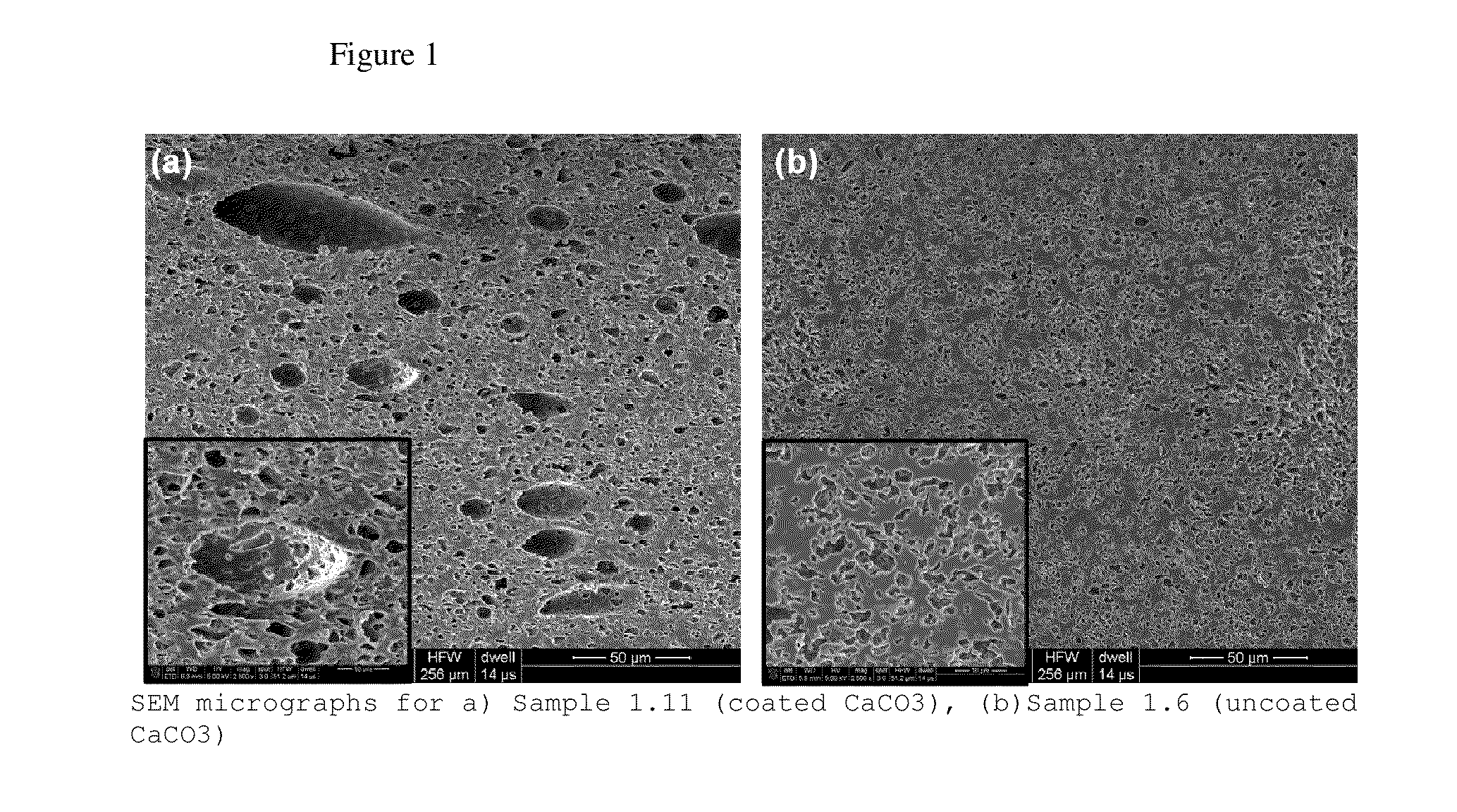Polyolefin based films with improved water vapor transmission rates
a polyolefin-based film and transmission rate technology, applied in the field of films, can solve the problems of impracticality of commercial use, aesthetic or structural damage to the building, and film made with these resins, and achieve the effect of reducing water droplet condensation
- Summary
- Abstract
- Description
- Claims
- Application Information
AI Technical Summary
Benefits of technology
Problems solved by technology
Method used
Image
Examples
example 1
[0039]Varying formulations with DOWLEX™ 2045G linear low density polyethylene (produced by The Dow Chemical Company, Density=0.920 g / cc and Melt Index=1.0 g / 10 min), and polyethylene glycol PEG CARBOWAX™ 8000 (produced by The Dow Chemical Company, flake form, molecular weight range 7000 to 9000 g / mol), having a Hansen solubility parameter of 33 MPa1 / 2, with either an uncoated CaCO3 (Omya F-FL grade from Omya Inc. USA, median diameter=1.4 μm, 60% finer than 2 μm, and 40% finer than 1 μm) or a coated CaCO3 (Omya FT-FL grade from Omya Inc. USA, coated with calcium stearate, median diameter=1.4 μm, 60% finer than 2 μm and 40% finer than 1 μm) are melt blended at 160° C. for 10 min using a Haake Rheocord mixing bowl (Haake Polylabs Systems). The screw speed is set at 50 rpm. Composition of the blends based on weight is listed in Table I.
[0040]Blends are compression molded into about 10 mil samples between two Mylar films using a Carver compression molding press. While samples of this thi...
example 2
[0045]DOWLEX™ 2045G (as in Example 1), polyethylene glycol Carbowax™ 1450 (produced by The Dow Chemical Company, flake form, molecular weight range 1305 to 1595 g / mol) and uncoated CaCO3 (Hubercarb Q1 grade supplied by J. M. Huber Corp., USA) of 1.1 micron mean particle size and 95% finer than 4 microns (both measurements by Sedigraph) are melt compounded and molded into about 10 mil thick samples, per protocol described in Example 1. While films of this thickness are outside the scope of the present invention, the data demonstrates trends of increased WVTR at higher levels of filler. WVTR is measured according to ASTM F1249-06 using a Mocon W700 measurement unit, at 38° C., with relative humidity of 100% on side and 0% on the other. Although the data is not presented in the table, films made with a blend of PEG and the LLDPE but without any filler show no substantial change in WVTR when compared to films comprising only the LLDPE. Note the data for Example 1 and Example 2 are not d...
example 3
Blown Films
[0047]Two formulations using the ingredients described in Example 1 are prepared through twin screw extrusion compounding and made into blown films. Compounding is carried out on a ZSK26 twin screw extruder (L / D=60 and D=26 mm) at a melt temperature of about 280° C., and an output rate of about 40 lb / h. Formulation ratios are given in Table III. The compounded pellets are dried at 80° C. for about 12 h to ensure a residual moisture level no more than 50 ppm prior to film extrusion. Monolayer blown films are made on a Killion blown film line equipped with a single screw extruder (D=1.2 inch and L / D=30, throughput of 10 lb / hr) and a 3 inch diameter die with 70 mil die gap. The melt temperature is at 162° C. The blow up ratio is 2.5 and film thickness is approximately 3 mils Samples are cut from blown films for WVTR measurement. The WVTR results are shown in Table III. WVTR is measured according to ASTM F1249-06 using a Mocon W700 measurement unit, at 38° C., with relative h...
PUM
| Property | Measurement | Unit |
|---|---|---|
| Length | aaaaa | aaaaa |
| Fraction | aaaaa | aaaaa |
| Percent by mass | aaaaa | aaaaa |
Abstract
Description
Claims
Application Information
 Login to View More
Login to View More - R&D
- Intellectual Property
- Life Sciences
- Materials
- Tech Scout
- Unparalleled Data Quality
- Higher Quality Content
- 60% Fewer Hallucinations
Browse by: Latest US Patents, China's latest patents, Technical Efficacy Thesaurus, Application Domain, Technology Topic, Popular Technical Reports.
© 2025 PatSnap. All rights reserved.Legal|Privacy policy|Modern Slavery Act Transparency Statement|Sitemap|About US| Contact US: help@patsnap.com

